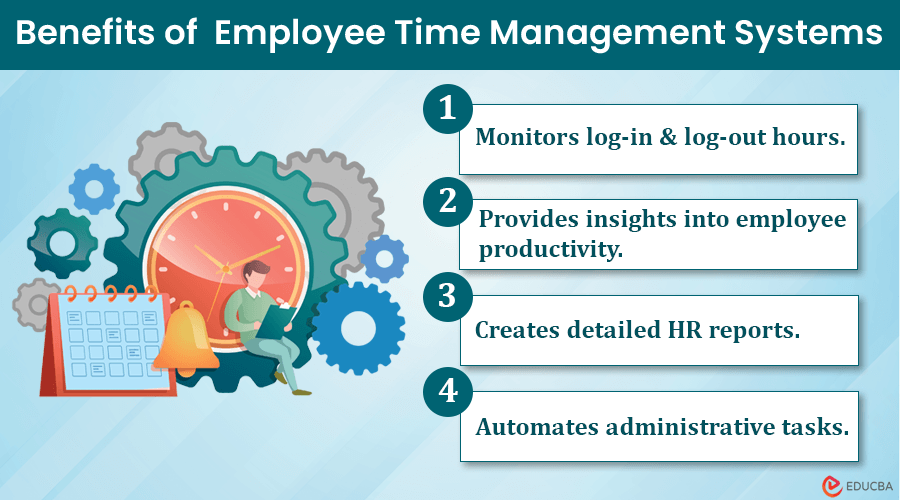
What are Employee Time Management Systems?
Employee time management systems monitor log-in and log-out hours, provide insights into employee productivity, create detailed HR reports, and automate administrative tasks.
As businesses constantly seek ways to streamline operations and improve productivity, employee time management systems have undergone significant changes and innovation. These systems have evolved from simple punch cards to advanced tools offering better functions and features than just tracking time.
Moreover, these modern time-tracking solutions automate administrative tasks, work smoothly with payroll systems, and provide real-time insights into employee productivity to calculate labor costs.
These changes reshape how companies track employees’ time, indirectly increasing workplace efficiency.
Table of Contents
Evolution of Employee Time Management Systems
Time management systems have evolved from punch cards to using advanced technology like automatic calculation, biometric data use, and even artificial intelligence (AI) systems.
Today, an employer can easily install a timesheet calculator on their computer or mobile device to track employees’ working hours. The software records the data on the website server. Also, timesheet software monitors log-in and log-out hours and highlights any deviations from the working hours norm.
Moreover, time management software helps HR create detailed automated employee reports with recorded data. They can select different report types, customize layouts, and perform calculations based on their.
Some employee time tracking software still allows manual entry of time taken to complete a task. This helps employees determine how long it takes to complete a given task and plan their schedules accordingly.
Another advantage of timesheet tools is accurate billing. Professionals across various industries can use these tools, including lawyers, freelancers, consultants, and accountants. The tools generate accurate timesheets to ensure fair compensation for the work done by clients.
Advancement in Employee Time Management System
Companies are using advanced technology to manage employee time efficiently. The following are some of the advancements in the employee time management system.
1. Biometric Technology
One of the biggest advancements in employee time management is biometric technology. Biometric time clocks use facial recognition, fingerprints, and sometimes iris scans to record time accurately. It reduces the time of manually entering log-in and log-out entry time data.
2. Online Time-Tracking Apps
Biometric time clocks are controversial and illegal in some jurisdictions. A convenient alternative to this is an online time clock app, which is more suitable. These tools have all the benefits of biometric time clocks. Moreover, the rise of remote work has increased the development of such mobile-friendly time management apps.
Features of online time clock apps are as follows.
- They allow employees to clock in and out from anywhere.
- These apps verify the employee’s location and prevent early clock-ins using geo-fencing technology.
- They track breaks and even send alerts about late arrivals, which helps to manage attendance.
- They provide flexibility and ensure accuracy.
They are valuable for companies with remote workers or hybrid work models. Employees using their devices for the clock-in eliminate the chances of “buddy punching.” Unlike biometric time clocks, which are subject to location-dependent privacy legislation, online time-tracking apps comply with all current laws. If biometric data laws change in your jurisdiction, you will still follow the law by using an online time-tracking app.
3. Artificial Intelligence Tools
Artificial intelligence (AI) is currently transforming the time clock technology. AI-powered time management systems can do far more than track time.
- It can predict the demand for staff.
- It can analyze working patterns.
- It can identify areas of operations improvement.
- It saves a lot of money and improves effectiveness.
Employees can install an AI-powered tracker on a computer, and it starts monitoring the apps they are using. These trackers can take screenshots and send the data to the web server for processing and analysis.
Some AI tools come with a “productivity” feature that evaluates the websites and apps employees use. Specifically, determining whether they are being productive. For example, accessing Microsoft Word would be productive, and Netflix would be unproductive. They can also customize these tools to recognize a platform as productive if using it professionally, such as YouTube. With time, these tools can help improve productivity at the workplace.
Final Thoughts
In conclusion, advancements in employee time management systems bring efficiency and accountability to the workplace. Businesses can track employee time using various options, from biometric technology to online time-tracking apps. These innovations also ensure compliance with changes in data privacy laws.
Recommended Articles
We hope this article on “Employee Time Management Systems” was informative. For more information, refer to the articles below.
